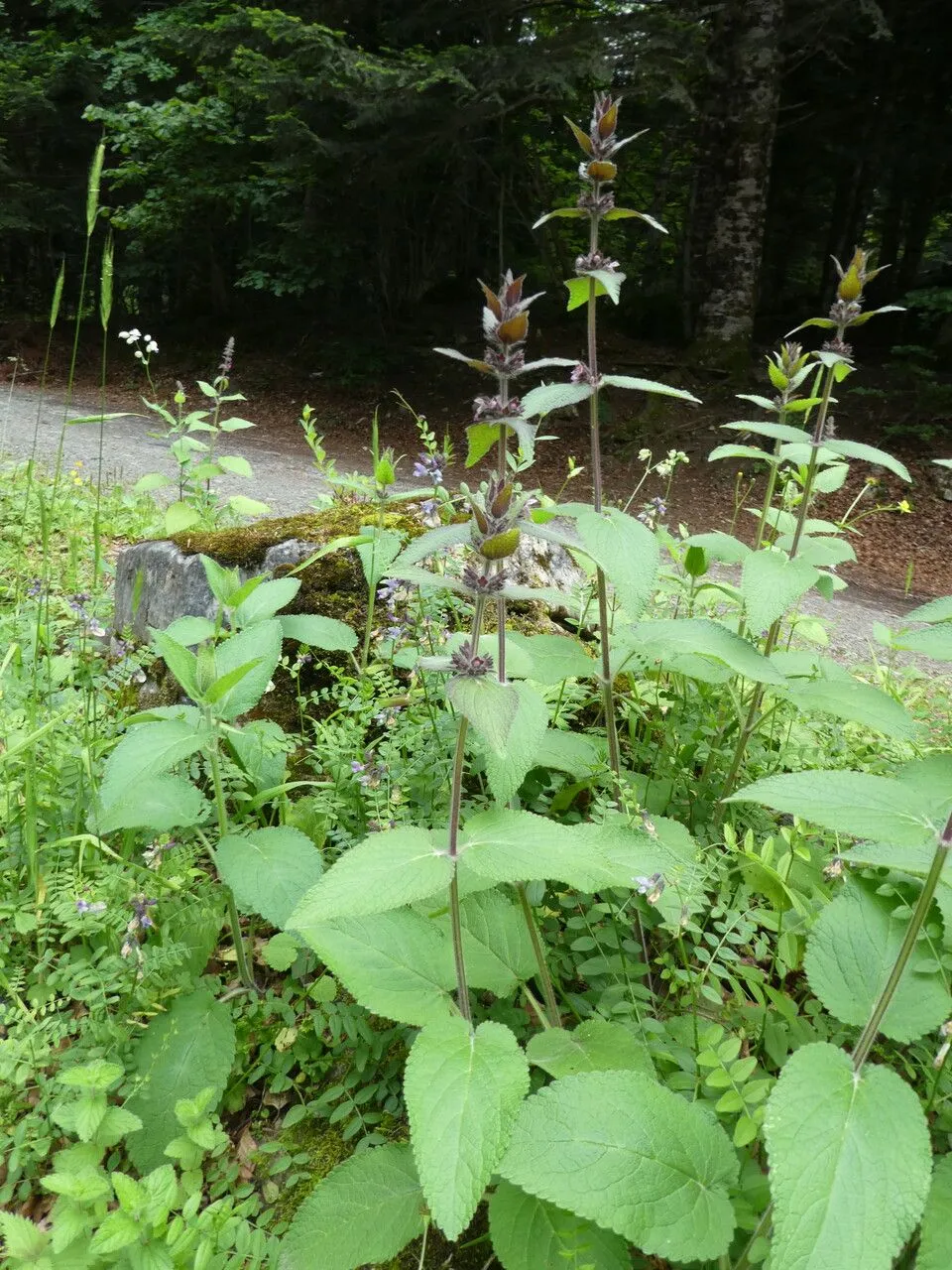
Author: L.
Bibliography: Sp. Pl.: 581 (1753)
Year: 1753
Status: accepted
Rank: species
Genus: Stachys
Vegetable: False
Observations: Europe to N. Iran
Limestone woundwort is a fascinating perennial herb known for its robust and resilient nature. Scientifically referred to as Stachys alpina, this plant is a member of the Lamiaceae family, a group recognized for its aromatic properties and significant botanical interest.
First classified in 1753, Limestone woundwort was described by the renowned botanist Carl Linnaeus in his seminal work, “Species Plantarum.” This classification marked the plant’s formal introduction into botanical literature and began its journey of scientific exploration and recognition.
The plant’s natural habitat stretches across a wide geographical range, encompassing much of Europe and extending into Northern Iran. This extensive distribution highlights its adaptability to various climates and terrains, specifically limestone-rich soil, which is indicative of its common name.
Limestone woundwort is typically found in mountainous regions, thriving at higher altitudes where it benefits from the cooler temperatures and well-drained, mineral-rich soil. Its presence in these regions is not only a testament to its hardiness but also to the ecological specificity it demands.
Botanically, Stachys alpina is distinguished by its square stems, a characteristic feature of the Lamiaceae family. It produces spikes of flowers, which are usually purple but can vary slightly in hue. The leaves of the plant are soft and hairy, giving them a somewhat woolly appearance, and they exude a faint, pleasant aroma when crushed.
This plant is particularly appreciated not just for its resilience and beauty but also for its traditional medicinal uses. Historically, parts of the Limestone woundwort have been used in herbal medicine, benefiting from the antiseptic and healing properties typically attributed to plants in the mint family.
In modern horticulture and ecological restoration projects, Limestone woundwort is valued for its ability to stabilize soil and enrich plant diversity in stony, challenging terrains. Its presence signals a healthy, balanced ecosystem, often providing habitat and food for various pollinators and small wildlife.
Understanding and appreciating Limestone woundwort, therefore, requires a consideration of its historical classification, broad and diverse habitat, distinctive botanical features, and both historical and contemporary significance. Its contribution to biodiversity and ecological health makes Stachys alpina a plant of notable importance within the natural world.
Deu: alpen-ziest
Eng: limestone woundwort, alpine woundwort
Nld: alpenandoorn
Swe: alpsyska
Cym: briwlys y calch, briwlys y calchfaen
En: Limestone Woundwort, Alpine Woundwort, Alpine Stachys
Ca: Estaquis alpina
Nl: Alpenandoorn
Fr: Épiaire des Alpes
De: Alpen-Ziest
It: Stregona alpina
Sv: Alpsyska
Cy: Briwlys y Calch, Briwlys y Calchfaen
: Limestone woundwort
Taken Jul 3, 2021 by Santiago (cc-by-sa)
Taken Jul 3, 2021 by Santiago (cc-by-sa)
Taken Jul 14, 2021 by Emanuele Santarelli (cc-by-sa)
Taken Jun 28, 2020 by André Hyvrier (cc-by-sa)
Taken Jun 28, 2020 by André Hyvrier (cc-by-sa)
© copyright of the Board of Trustees of the Royal Botanic Gardens, Kew.
© copyright of the Board of Trustees of the Royal Botanic Gardens, Kew.
© copyright of the Board of Trustees of the Royal Botanic Gardens, Kew.
Taken Jul 9, 2016 by Tela Botanica − Yoan MARTIN (cc-by-sa)
Taken Jul 9, 2016 by Tela Botanica − Yoan MARTIN (cc-by-sa)
Taken Jul 9, 2016 by Tela Botanica − Yoan MARTIN (cc-by-sa)
Taken Sep 8, 2021 by mylene serusier (cc-by-sa)
Taken Apr 14, 2022 by Étienne Girardot (cc-by-sa)
Taken Jul 8, 2021 by Llandrich anna (cc-by-sa)
Taken Jul 24, 2019 by herve (cc-by-sa)
Taken Jul 9, 2016 by Tela Botanica − Yoan MARTIN (cc-by-sa)
Taken Jul 23, 2016 by Tela Botanica − Yoan MARTIN (cc-by-sa)
Taken Jul 23, 2016 by Tela Botanica − Yoan MARTIN (cc-by-sa)
Taken Jul 24, 2021 by Pietro Brignoli (cc-by-sa)
Taken Jun 7, 2022 by Frédéric Nowak Gontero (cc-by-sa)
Taken Jul 7, 2014 by Tela Botanica − CENTRE DE LA NATURE MONTAGNARDE (cc-by-sa)
Taken Jun 20, 1998 by Tela Botanica − Liliane Roubaudi (cc-by-sa)
Taken Jun 20, 1998 by Tela Botanica − Liliane Roubaudi (cc-by-sa)
Taken Aug 14, 2022 by feuilles alternes (cc-by-sa)
Taken Jul 15, 2007 by Photoflora – Benoit BOCK (©)
Taken Aug 15, 2003 by Photoflora – Benoit BOCK (©)
Taken Jul 15, 2007 by Photoflora – Benoit BOCK (©)
Taken Nov 5, 2022 by Ya Eric (cc-by-sa)
Taken May 31, 2020 by Chris Georges (cc-by-sa)
Taken Aug 14, 2022 by feuilles alternes (cc-by-sa)
Taken Jul 15, 2010 by Photoflora – Benoit BOCK (©)
Taken Jul 23, 2016 by Tela Botanica − Yoan MARTIN (cc-by-sa)
Taken Jul 23, 2016 by Tela Botanica − Yoan MARTIN (cc-by-sa)
Ph maximum: 7.5
Ph minimum: 7.0
Light: 7
Atmospheric humidity: 7
Bloom months: [‘jun’, ‘jul’, ‘aug’]
Soil nutriments: 6
Family: Myrtaceae Author: (F.Muell.) K.D.Hill & L.A.S.Johnson Bibliography: Telopea 6: 402 (1995) Year: 1995 Status:…
Family: Rubiaceae Author: Pierre ex A.Froehner Bibliography: Notizbl. Bot. Gart. Berlin-Dahlem 1: 237 (1897) Year:…
Family: Sapindaceae Author: Koidz. Bibliography: J. Coll. Sci. Imp. Univ. Tokyo 32(1): 38 (1911) Year:…
Family: Asteraceae Author: A.Gray Bibliography: Pacif. Railr. Rep.: 107 (1857) Year: 1857 Status: accepted Rank:…
Family: Fabaceae Author: Medik. Bibliography: Vorles. Churpfälz. Phys.-Ökon. Ges. 2: 398 (1787) Year: 1787 Status:…
Family: Aspleniaceae Author: (Cav.) Alston Bibliography: Bull. Misc. Inform. Kew 1932: 309 (1932) Year: 1932…